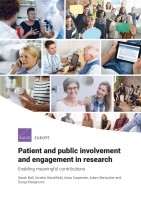| 来源类型 | Research Reports
|
| 规范类型 | 报告
|
| DOI | https://doi.org/10.7249/RR2678
|
| 来源ID | RR-2678-THIS
|
| Patient and public involvement in research: Enabling meaningful contributions |
| Sarah Ball; Amelia Harshfield; Asha Carpenter; Adam Bertscher; Sonja Marjanovic
|
| 发表日期 | 2019
|
| 出版年 | 2019
|
| 页码 | 94
|
| 语种 | 英语
|
| 结论 |
Motivations for involvement- Patients and the public engage with research for a variety of reasons spanning: (i) interest in a healthcare topic, often driven by personal experience of a disease or of the health service; (ii) altruistic motivations to contribute to a better healthcare system through research; (iii) a desire to influence and reflect patient perspectives in research; and (iv) a more general interest in research activity and in contributing to scientific knowledge.
Approaches to involvement- PPI in health research can take place across different stages of a research cycle and at the level of an individual project, a portfolio of projects or at the organisational level. The duration, frequency or regularity of patient and public engagement can range from ad hoc, task-based contributions to long-term engagement across the lifetime of a project or research organisation.
Challenges, enablers and impacts- Challenges to effective PPI in research relate to governance and management issues, the capacity of individuals to engage, administrative challenges and challenges related to culture, values and attitudes. However, the growing focus on and increased commitment to PPI within research over the past decade has also revealed some key enabling mechanisms and rewards (e.g. feedback on contributions and on project progress and impacts; acknowledgment and recognition of contributions; learning and personal development opportunities).
- The core categories of potential or realised impact from PPI in research span impacts on individuals (e.g. empowerment, influence), on research quality and relevance and on the wider research system (e.g. accountability for resource-use).
|
| 摘要 |
- Think carefully about who to involve and why.
- Ensure roles of PPI contributors are clear and well communicated.
- Ensure that PPI contributors are well informed and supported to effectively engage.
- Think about ethical considerations.
- Build in monitoring and evaluation mechanisms.
- Report on the methods used to engage patients and the public and on involvement outcomes.
- Design efforts to recruit and retain patient and public contributors in a way that reflects the diverse factors which motivate them.
- Consider the mix of approaches that will allow for effective awareness raising and recruitment.
- Enable engagement through a mix of levers.
|
| 主题 | Biomedical Research
; Medical Professionals
; Patient Experience
; Survey Research Methodology
|
| URL | https://www.rand.org/pubs/research_reports/RR2678.html
|
| 来源智库 | RAND Corporation (United States)
|
| 引用统计 |
|
| 资源类型 | 智库出版物
|
| 条目标识符 | http://119.78.100.153/handle/2XGU8XDN/108976
|
推荐引用方式
GB/T 7714 |
Sarah Ball,Amelia Harshfield,Asha Carpenter,et al. Patient and public involvement in research: Enabling meaningful contributions. 2019.
|
|
文件名:
|
x1550166877073.jpg
|
|
格式:
|
JPEG
|

|
文件名:
|
RAND_RR2678.pdf
|
|
格式:
|
Adobe PDF
|
除非特别说明,本系统中所有内容都受版权保护,并保留所有权利。